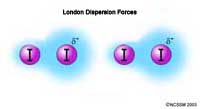At 25 C, F_2 is a gas but I_2 is a solid. What is most likely the case of this?
1 Answer
The most likely cause is that the attractive forces between the molecules of
Explanation:
The molecules of each substance attract each other through London dispersion forces.
Whether a substance is a solid, liquid, or gas depends on the balance between the kinetic energies of the molecules and their intermolecular attractions.
Molecules at the same temp have the same average kinetic energy (
In fluorine, the electrons are tightly held to the nuclei.
The electrons have little chance to wander to one side of the molecule, so the London dispersion forces are relatively weak.
At room temperature, the fluorine molecules have enough energy to escape these attractive forces.
The attractions are not strong enough to make fluorine condense or solidify.
In iodine, the electrons are so far from the nuclei that the electron clouds can easily distort.
The London dispersion forces are strong.
 www.dlt.ncssm.edu
www.dlt.ncssm.edu
The molecules no longer have enough kinetic energy to escape the attractive forces.
The attractions are strong enough to cause the iodine to be a solid at room temperature.

